
|
Keyword: molecular cloud
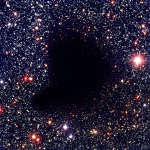 Dark Molecular Cloud Barnard 68
Dark Molecular Cloud Barnard 68
21.11.2020
Where did all the stars go? What used to be considered a hole in the sky is now known to astronomers as a dark molecular cloud. Here, a high concentration of dust and molecular gas absorb practically all the visible light emitted from background stars.
 IC 5146: The Cocoon Nebula
IC 5146: The Cocoon Nebula
26.08.2022
Inside the Cocoon Nebula is a newly developing cluster of stars. Cataloged as IC 5146, the beautiful nebula is nearly 15 light-years wide. Climbing high in northern summer night skies, it's located some 4,000 light years away toward the constellation Cygnus the Swan.
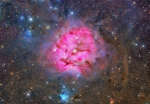 APOD: 2024 August 19 Б IC 5146: The Cocoon Nebula
APOD: 2024 August 19 Б IC 5146: The Cocoon Nebula
18.08.2024
Inside the Cocoon Nebula is a newly developing cluster of stars. Cataloged as IC 5146, the beautiful nebula is nearly 15 light-years wide. Soaring high in northern summer night skies, it's located some 4,000 light years away toward the constellation of the Swan (Cygnus).
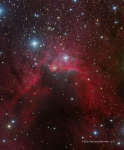 SH2-155: The Cave Nebula
SH2-155: The Cave Nebula
22.03.2017
This skyscape features dusty Sharpless catalog emission region Sh2-155, the Cave Nebula. In the telescopic image, data taken through a narrowband filter tracks the reddish glow of ionized hydrogen atoms. About 2,400 light-years away, the scene lies along the plane of our Milky Way Galaxy toward the royal northern constellation of Cepheus.
 APOD: 2023 January 29 Б Barnard 68: Dark Molecular Cloud
APOD: 2023 January 29 Б Barnard 68: Dark Molecular Cloud
28.01.2023
Where did all the stars go? What used to be considered a hole in the sky is now known to astronomers as a dark molecular cloud. Here, a high concentration of dust and molecular gas absorb practically all the visible light emitted from background stars.
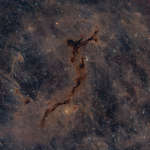 The Dark Seahorse in Cepheus
The Dark Seahorse in Cepheus
19.04.2023
Spanning light-years, this suggestive shape known as the Seahorse Nebula appears in silhouette against a rich, luminous background of stars. Seen toward the royal northern constellation of Cepheus, the dusty, obscuring clouds are part of a Milky Way molecular cloud some 1,200 light-years distant.
 Dark Molecular Cloud Barnard 68
Dark Molecular Cloud Barnard 68
7.10.2017
Where did all the stars go? What used to be considered a hole in the sky is now known to astronomers as a dark molecular cloud. Here, a high concentration of dust and molecular gas absorb practically all the visible light emitted from background stars.
 Cocoon Nebula Deep Field
Cocoon Nebula Deep Field
18.09.2018
Inside the Cocoon Nebula is a newly developing cluster of stars. The cosmic Cocoon on the upper right also punctuates a long trail of obscuring interstellar dust clouds to its left. Cataloged...
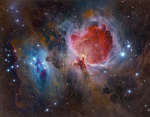 Great Orion Nebulae
Great Orion Nebulae
13.09.2011
The Great Nebula in Orion, also known as M42, is one of the most famous nebulas in the sky. The star forming region's glowing gas clouds and hot young stars...
 Chamaeleon I Molecular Cloud
Chamaeleon I Molecular Cloud
26.05.2024
Dark markings and bright nebulae in this telescopic southern sky view are telltale signs of young stars and active star formation. They lie a mere 650 light-years away, at the boundary of the local bubble and the Chamaeleon molecular cloud complex.
|
January February March April May June July August September |
||||||||||||||||||||||||||||||||||||||||||||||||||||||||